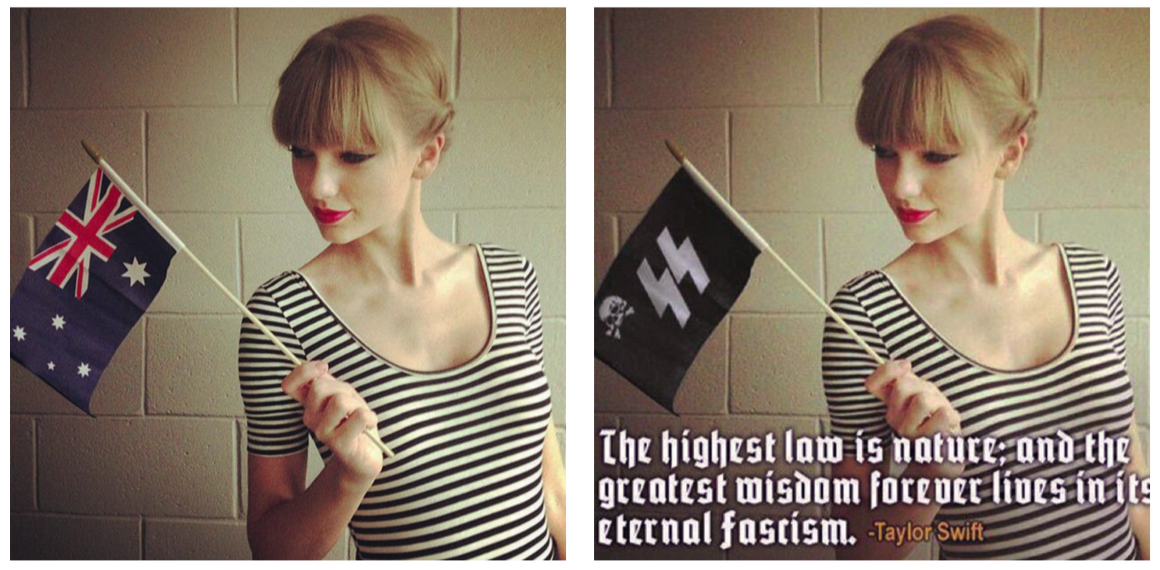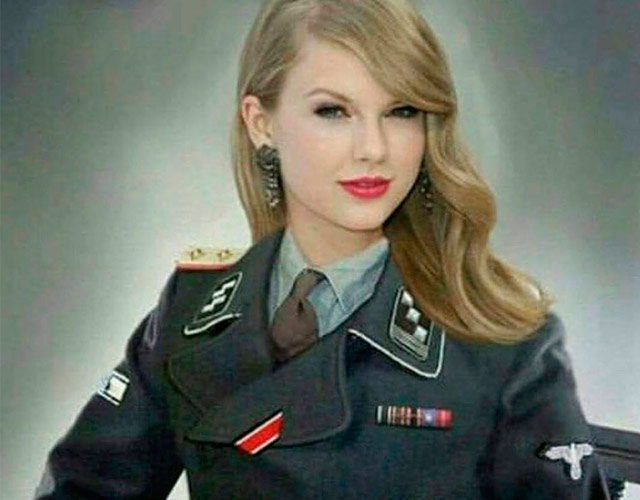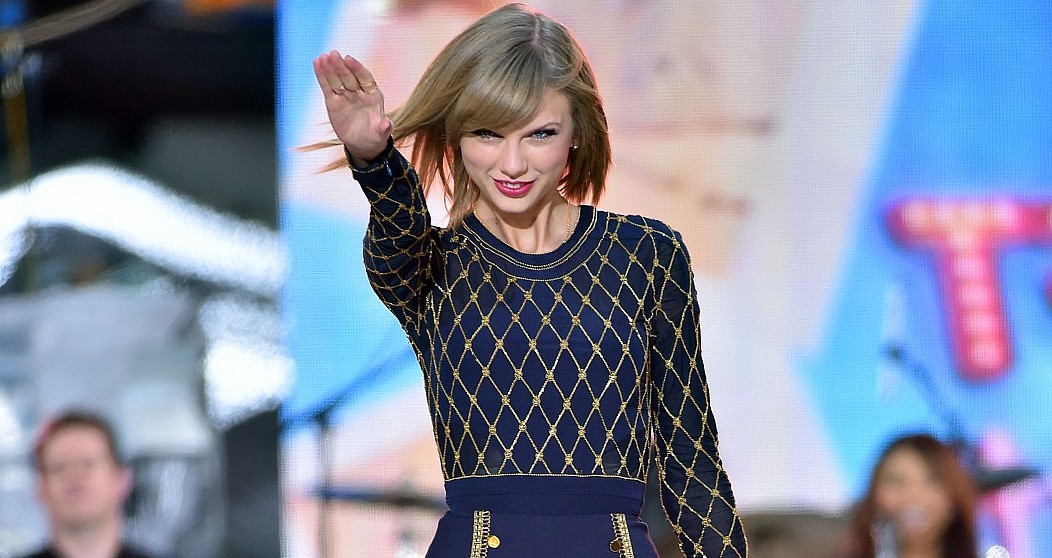We Never Go Out of Style
by Zachary Woolfe

A photograph from Taylor Swift’s Instagram feed, and an edit by a curious admirer. 2016.
This article appears in Even no. 6, published in spring 2017.
Taylor Swift was not born anywhere near Nashville, where her family moved when she was 14 to encourage her budding music career. The girl who’s gone to so much trouble to seem country is really a northern suburbanite, raised in Cumru Township (94% white) and then Wyomissing (95% white), small communities just outside Reading (48% white). Reading is the seat of Berks County, Pennsylvania (77% white), an hour’s drive northwest of Philadelphia, and the plants that long buoyed its economy, including those of Lucent Technologies and the Dana car-parts manufacturer, gradually shriveled away. Less than a tenth of its residents has a bachelor’s degree, and the city’s poverty rate has climbed to 41.3% — edging out Flint, Michigan, to make it the poorest city in the country. Berks County had voted for the Republican candidate for president ten times in a row until 2008, when Barack Obama won it by nine points. In 2012 Mitt Romney got it back, but only by a hair. But in 2016, Swift’s home county was one of the hundreds that fell in behind Trump’s romp through the undereducated, underemployed white northeast. He carried Berks by 10 points, 52.9% to 42.7%.
Screaming, crying, perfect storms; I could make all the tables turn.... Take the above as context for the rather remarkable fact that, unlike practically every other American pop star, we do not know whom Taylor Swift voted for in any of the last three elections. Though she posed for Instagram in line at her polling place on November 8 — in oddly funereal, goth-ish black, her lips parted into a seen-it-all moue that netted her 2.4 million likes — she remained conspicuously quiet about which candidate she was supporting. From Katy Perry, her fellow wholesome pop princess, we’d had a full year of I’m With Her declarations; Hillary Clinton used “Roar” as the soundtrack for her final battleground state advertising. Lady Gaga appeared on the stump with Clinton, wearing a jacket that Michael Jackson once wore to the White House; Miley Cyrus knocked on doors in Virginia; Beyoncé and Jay Z campaigned for her in Cleveland, while Mary J. Blige, in one of the campaign’s more bizarre video releases, grasped Hillary’s hand in a hotel suite and scatted about police brutality. Swift, alone, kept mum.
Whether or not Swift voted for Trump — dig around on low-margin celebrity gossip pages and you’ll find it claimed that she wrote “Republicans do it better” on an old MySpace page — it would be the cherry on top of the adoring coverage that Swift, uniquely among this country’s biggest celebrities, receives on websites that some call “alt-right,” and that we prefer to call “white nationalist.” Andrew Anglin, who writes the avowedly neo-Nazi blog The Daily Stormer, has called her “a pure Aryan goddess, like something out of classical Greek poetry.” Another alt-right blogger, this one female, celebrated her as “the embodiment of healthy southern values.” And in the post-verbal media of Twitter and Facebook, Swift now frequently appears in mocked-up photos cribbed from her own social media feed, and kitted out with SS flags, stormtrooper uniforms, swastika armbands, and Gothic-lettered Jew-hatred. (Below Swift in a ball gown in the woods, a caption from Hitler: “As in everything, nature is the best instruction.”)

As with Pepe, the innocent frog cartoon co-opted by Trumpists as a neo-Nazi emblem, it was hard to know during this madhouse election whether “trolling” racism was feeding “sincere” racism, or vice versa. (Hard to know, too, whether the difference matters.) What is incontrovertible is that Swift is pretty, white, and blonde — “Nazi Barbie,” Camille Paglia sniffed — and that she grew up on, yes, a Christmas tree farm. Gaze upon her buffed-to-shine Instagram feed, with its insouciant poses at cookouts and sleepovers, its American flags waving from small-craft boats; sing along to “You Belong To Me,” whose video sees T-Swift mooning in her suburban bedroom before heading to a high school football game. Summarizing her appeal to the alt-right, the gay conservative troll Milo Yiannopoulos adds that, unlike most pop stars, white and black, Swift “doesn’t go in for racial ambiguity.”
Indeed, American racists have likely been emboldened by the fact that the pop culture and women’s fashion press, currently grinding out woke clickbait in its latest struggle for lost profitability, has cooled on Swift, accusing her of disloyalty to feminism and blindness to black culture. Her notorious spat with Nicki Minaj was only the start of it; there was the “Shake It Off” video, in which she crawled beneath the legs of twerking black dancers, and the more tasteless clip for “Wildest Dreams,” set in a fantasy colonial Africa of khaki dresses and wind machines: Karen Blixen routed through a Ralph Lauren ad. Swift’s mainstream disapproval, in fact, may serve for American extremists — who now condemn all media with the Nazi term Lügenpresse — as dispositive proof of her alt-right bona fides. “It’s incredible really that she’s surrounded by these filthy, perverted Jews,” The Daily Stormer writes, “and yet she remains capable of exuding 1950s purity, femininity, and innocence.”

The irony of Swift’s Nazification is that the Wonder Bread pop star is a neurotic curator of her image, emitting only the safest of soft-feminist statements and keeping all other beliefs under wraps. (“I don’t think that I know enough yet in life to be telling people who to vote for,” she told Time just before the 2012 election.) She has, of course, said nothing about the Photoshopped pictures of her in Wehrmacht uniform, but the calculated minimalism of her self-defense on charges of illiberalism has made it easy for both the mainstream and extremist rights to absorb her. “Taylor is terrific!” the new president tweeted four years ago, in one of his many out-of-nowhere pronouncements on pop culture and women’s bodies. And Swift was, in fact, a kind of Trumpist before Trump, another anti-ideologue whose main gift was to function as a screen onto which pre-teens and racists alike could project their terrors and desires. “I’ve got a blank space, baby,” she sings: but now, amid fans’ digital empowerment vis-à-vis the celebrities they worship, you can write your own name, or Joseph Goebbels’s if you prefer.
Blank spaces, though, are never really blank. Among the most disturbing trends of this election was how many white women like her — who live just past the outskirts of cities where economic hell really did break loose; who imagine themselves apolitical, yet vividly perceive barbarians at the gates — in the end held their noses, or not, and lined up for Trump. Suburban Nashville and suburban Reading turn out to be not so far from each other, and to be as glibly ni-droite-ni-gauche as Swift is to be, inevitably, at one purpose with the tragedy that has befallen us.